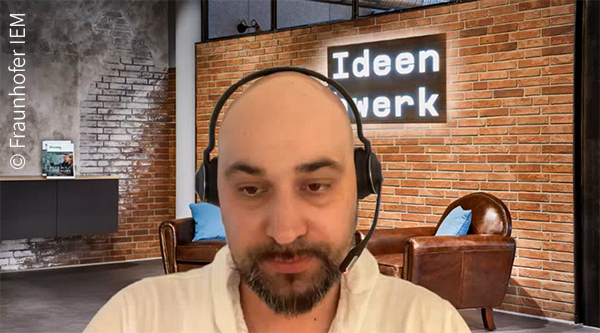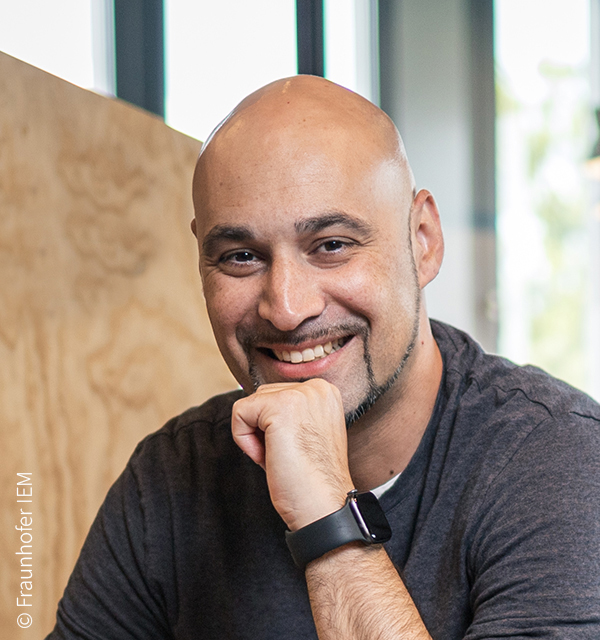
|
AI can help establish an end-to-end engineering processAn Interview with Roman Dumitrescu ChatGPT has transformed artificial intelligence (AI) into a topic that is surrounded by a lot of hype. While AI is already being used in production, it is only just starting to be adopted in the product development field. In an interview for the PROSTEP Newsletter, Professor Roman Dumitrescu, one of the directors of the Fraunhofer IEM in Paderborn, explains the potentials that enterprises are letting pass them by. 
Question: For a long time, it was said that German companies were lagging behind their Chinese and American counterparts in terms of AI adoption. Is that still the case? Dumitrescu: If you look at the Stanford AI Index Report, which contains a large number of AI-related benchmarks, then there is one dimension for which that is definitely true: The USA, in particular, is way ahead of us when it comes to private-sector risk investment. But that doesn’t really have anything to do with AI per se, because it’s an area in which we have never been great. Even if you consider AI as an economic sector, then we in Germany are much less well positioned than the Chinese and Americans. But this again does not correspond at all to our business model. Our strength lies in our manufacturing industry and there we have a considerable lead as far as the adoption of AI is concerned. And the report also mentions criteria on which we do very well, for example in the collaboration between research and industry. This level of cooperation does not exist in other countries. Germany boasts a good, broad-based AI research sector. Question: How many businesses have any experience of AI at all, ignoring the fact that they have probably all played around with ChatGPT a bit? Dumitrescu: The question is what do you mean by experience? Companies are already doing quite a lot with regard to the question of AI, for example in the fields of production planning, condition monitoring or predictive maintenance. I can’t think of any modern production lines, even in small SMEs, where AI hasn’t at least been given a try. However, when it comes to exploiting the strategic benefits of this technology, the number of companies is probably down in the single-digit range, and not only in Germany. 
Question: At present, what sorts of application is AI primarily being used for? Is engineering already on the list? Dumitrescu: I have been working for years on the topic of AI in engineering and I can tell you that it is still difficult even today to convince businesses that AI is an immensely powerful lever with enormous potential. It is already being used very extensively in the production planning field, but its adoption in product development is still pretty much in its infancy. Here, it is only thanks to ChatGPT that the topic has started to attract more attention, because people have recognized that it is a very good tool for analyzing, documenting or even creating software codes. Question: What are the greatest challenges to the implementation of AI in engineering? Dumitrescu: Here, I could say a lot about data protection or the limitations of AI processes but I don’t want to do that because it would give the wrong message. We are talking about technologies that are sometimes very recent, where we need to acquire a lot more experience and where the boundary conditions haven’t yet been established. The AI Act has attempted to create these conditions. The real challenge lies in the fact that businesses don’t recognize the various levers that are available to them because they don’t really understand what is involved. There is a genuine lack of understanding. Typical SMEs just don’t have the time to get to grips with the topic. Question: So how should SMEs with limited human and financial resources go about exploiting the potential offered by AI? Dumitrescu: The great advantage that Germany possesses is that we have a network of enterprises and a wealth of universities and research institutes. We don’t have to do everything ourselves. If we are to become competitive in the AI field, then the obvious solution is co-innovation, that is to say a form of cooperation in which issues are addressed jointly. Companies should look for regional partners, participate actively in networks and seek to work together with other enterprises that are in a similar position. Although different machine and plant manufacturers may service different markets, they are nevertheless all faced by very similar challenges. Question: How can the situation be improved by platforms like the AI Marketplace, which arose as a research product at Paderborn University? Dumitrescu: That was more than just a research project. The German Federal Ministry for Economic Affairs wanted to encourage ecosystems to promote innovation in AI and we had the idea of constructing an ecosystem for engineering because we had seen that the issue of AI was not being pursued in this field. At least, not in any targeted or strategic way. Even though there are AI solutions, on the one hand, and a need for them, on the other, suppliers and consumers have yet to link up. That is why we created a platform that puts start-ups and cutting-edge research in touch with the business world and aids in the identification of use cases. The aim of the project was to set up a company and that is indeed now up-and-running. Question: What are the most interesting use cases for AI in engineering or, in other words, does it always have to take the form of a large language model? Dumitrescu: No, not necessarily, but that does play an important role. Naturally, the best known areas are topology or simulation optimizations, that is to say algorithms that can be used to optimize the solutions to design problems. But if you ask me what I consider to be the most interesting use cases, then I would point to the large language models in requirements engineering. That is a megatopic. Anyone who has been involved in product development knows just how important requirements are, from their identification and collation, through maintenance and on to ensuring consistency between requirements, etc. Large language models are a very good way of helping to improve the way such requirements lists are maintained and optimized. Question: Is it conceivable that we will one day get AI to generate complex product models for us? Dumitrescu: It is theoretically conceivable, but we are still a very long way from reaching that point. At the moment, we are happy if we are able to use AI to generate simple geometries, and generating geometries is not the greatest challenge in the engineering field. Instead, this lies in the interlinking of disciplines and domains. I actually tend to think that AI will help us explore the solution space better. What did you mean by that? Developers are perfectly capable of designing good solutions but they are not able to come up with three or four good proposals within a predefined timeframe. Here, AI can help us to generate two or three additional alternatives and consequently to become more innovative. Question: So you don’t think there is a danger that engineers will simply become mere assistants doing the AI’s bidding? Dumitrescu: No, there is no need to be afraid of anything like that. I am convinced that working with this type of AI-based system will be a lot of fun. Things can’t get any worse than they are at the moment. Developers spend practically all their time acquiring, comparing and harmonizing information. Hopefully, AI will reduce this burden so that developers are better able to make genuine design decisions. There are people in the USA who say that we are now all becoming AI engineers and it is AI that will develop the products. That’s a naive way of looking at things and it won’t work. We still need mechanical engineers, electronic engineers and software engineers. Question: Data is the new oil, and that includes data for training AI. Do we in the engineering world have enough data or do we need shared dataspaces? Dumitrescu: Here, I’m slightly in two minds. In Germany, we have initiatives such as Gaia-X, Catena-X or Manufacturing-X and I have personally been working to make sure we also have an Engineering-X. However – and this is typically German – we expend most of our time and effort making sure that these dataspaces are secure and trustworthy without answering the question of whether they have any genuine value added for industry. After twelve years spent researching data-based business models, I still doubt whether businesses will ever share important enterprise data, irrespective of how trustworthy the dataspaces are. And in the engineering field, we are talking about the really important data. I therefore fear that the use case will never arise, even though we are investing an immense amount of time and effort researching the solutions for it. Perhaps it would be better to start by examining how much data companies need in order to use AI purposefully in their engineering activities. And then they will see that they already have a huge amount of it. We haven’t even taken a close look at this "data lake" and we’re already thinking about heading out into the open seas. Question: What issues relating to the use of AI in engineering are you addressing in your current research activities? Dumitrescu: Our research roadmap pursues three main avenues. In the short term, it will be important to develop concrete co-pilots or AI assistance systems for certain engineering process steps. The third, and more long-term, area of research relates to what the engineering IT infrastructure of the future will look like and what role large language models will play in it. Large language models will also fundamentally change the way we look at PLM and solve many problems, such as the issue of migrating data when switching between systems. The second research topic, and my personal favorite, is how AI can help establish an end-to-end engineering process. For years, we have been talking about networked engineering, cross-domain traceability or digital twins but always come across the stumbling block that people don’t do any updating or connecting of data. AI can help us automatically update documentation and create links that the developer didn’t see or preferred to ignore. At the moment, we are suffering from the fact that we have no end-to-end systems engineering. However, that is what we need if we are to speed up our development activities. Professor Dumitrescu, thank you very much for this interesting interview. (This interview was conducted by Michael Wendenburg) 
About Professor Roman Dumitrescu Professor Roman Dumitrescu is one of three directors of the Fraunhofer Institute for Mechatronic Systems Design (IEM) in Paderborn, where he is responsible for the Product Development research unit. In his role as W3 professor, he also teaches Advanced Systems Engineering at Paderborn University’s Faculty of Computer Science, Electrical Engineering and Mathematics and is managing director of the technology network Intelligent Technical Systems OstWestfalenLippe (it´s OWL). The focus of his research includes cross-disciplinary development management, model-based systems engineering (MBSE) and the use of artificial intelligence in engineering. Professor Dumitrescu studied mechatronics at the Friedrich-Alexander University Erlangen-Nuremberg and subsequently worked as a research assistant in the Department of Product Development at the Heinz Nixdorf Institute of the University of Paderborn. In 2010, he received his doctorate in the field of systems engineering for intelligent mechatronic systems under the mentorship of Professor Jürgen Gausemeier. |
|
| © PROSTEP AG | ALL RIGHTS RESERVED | IMPRINT | PRIVACY STATEMENT | YOU CAN UNSUBSCRIBE TO THE NEWSLETTER HERE. |
